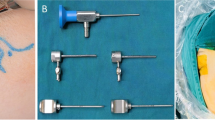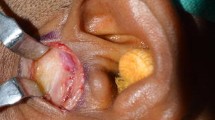Abstract
Objective
To evaluate the feasibility and effectiveness of using a suture-free titanium screw in repositioning anterior disc displacement without reduction (ADDwoR) of the temporomandibular joint (TMJ).
Methods
A consecutive sample of twelve patients (fifteen joints) was included in this study. All patients were diagnosed with ADDwoR and showed limited mouth opening or temporomandibular joint pain symptoms. Suture-free titanium screw was placed in the condyle directly following the disc repositioning. Pre- and postoperative evaluation parameters include operation time, the visual analogue scale for pain (VAS), lateral excursion movements (LEM), maximum interincisal opening (MIO), and disc length and position on MRI. In addition, the mandibular condyle height was also measured. Statistical significance was considered when p < 0.05.
Results
The unilateral operation time was 58.54 ± 5.43 min; during the 6-month period after the operation, the VAS values decreased from 87 ± 6.34 to 14.08 ± 6.65. The MIO increased from 30.07 ± 4.73 to 39.89 ± 1.69 mm (p = 0.01). The TMJ disc length was prolonged from 8.23 ± 1.12 to 11.51 ± 1.29 mm. The condyles showed significant remodeling, and the height of the condyle increased from 18.24 ± 4.12 increase to 19.6 ± 4.31 mm. The LEM was increased from 5.27 ± 0.51 to 6.36 ± 0.62 mm. The MRI images showed the stability of the disc in position during the opening and closing of the mouth. The TMJ disc position was stable during the follow-up period.
Conclusion
Anteriorly displaced articular disc can be repositioned by a suture-free titanium screw strategy. This technique is an alternative method to address ADDwoR.



Similar content being viewed by others
Data availability
The authors confirm that the data supporting the findings of the study are available within the article and that the datasets used and/or analyzed during the current study are available from the corresponding author upon reasonable request.
References
Goss AN (1993) Toward an international consensus on temporomandibular joint surgery. Report of the Second International Consensus Meeting, April 1992, Buenos Aires, Argentina[J]. Int J Oral Maxillofac Surg 22(2):78–81
Hall HD (1995) Intra-articular disc displacement Part II: Its significant role in temporomandibular joint pathology[J]. J Oral Maxillofac Surg 53(9):1073–1079
Katzberg RW, Westesson PL, Tallents RH et al (1996) Anatomic disorders of the temporomandibular joint disc in asymptomatic subjects[J]. J Oral Maxillofac Surg 54(2):147–53 (discussion 153-5)
Sidebottom AJ (2009) Current thinking in temporomandibular joint management[J]. Br J Oral Maxillofac Surg 47(2):91–94
Shifman A, Gross MD (2001) Diagnostic targeting of temporomandibular disorders[J]. J Oral Rehabil 28(11):1056–1063
Meyers RA, Schellhas KP, Hall HD et al (1992) Guidelines for diagnosis and management of disorders involving the temporomandibular joint and related musculoskeletal structures. American Society of Temporomandibular Joint Surgeons[J]. Northwest Dent 71(5):21–7
Mehra P, Wolford LM (2001) The Mitek mini anchor for TMJ disc repositioning: surgical technique and results[J]. Int J Oral Maxillofac Surg 30(6):497–503
Zhang S, Liu X, Yang X et al (2010) Temporomandibular joint disc repositioning using bone anchors: an immediate post surgical evaluation by magnetic resonance imaging[J]. BMC Musculoskelet Disord 11:262
Zhou Q, Zhu H, He D et al (2019) Modified Temporomandibular Joint Disc Repositioning With Mini-screw Anchor: Part II-Stability Evaluation by Magnetic Resonance Imaging[J]. J Oral Maxillofac Surg 77(2):273–279
He D, Yang C, Zhu H et al (2018) Temporomandibular Joint Disc Repositioning by Suturing Through Open Incision: A Technical Note[J]. J Oral Maxillofac Surg 76(5):948–954
He D, Yang C, Zhang S et al (2015) Modified temporomandibular joint disc repositioning with miniscrew anchor: part I–surgical technique[J]. J Oral Maxillofac Surg 73(1):47 e1–9
Arat FE, Arat ZM, Tompson B et al (2008) Muscular and condylar response to rapid maxillary expansion. Part 2: magnetic resonance imaging study of the temporomandibular joint[J]. Am J Orthod Dentofacial Orthop 133(6):823–9
Nebbe B, Major PW, Prasad NG (1999) Male adolescent facial pattern associated with TMJ disk displacement and reduction in disk length: Part II[J]. Am J Orthod Dentofacial Orthop 116(3):301–307
Liu X, Zhou Z, Mao Y et al (2019) Temporomandibular joint anchorage surgery: a 5-year follow-up study[J]. Sci Rep 9(1):19106
He D, Yang C, Zhang S et al (2015) Modified temporomandibular joint disc repositioning with miniscrew anchor: part I–surgical technique[J]. J Oral Maxillofac Surg 73(1):47.e1–9
Israel HA (1989) Technique for placement of a discal traction suture during temporomandibular joint arthroscopy[J]. J Oral Maxillofac Surg 47(3):311–313
Mccain JP, Podrasky AE, Zabiegalski NA (1992) Arthroscopic disc repositioning and suturing: a preliminary report[J]. J Oral Maxillofac Surg 50(6):568–79 (discussion 579-80)
Yang C, Cai XY, Chen MJ et al (2012) New arthroscopic disc repositioning and suturing technique for treating an anteriorly displaced disc of the temporomandibular joint: part I–technique introduction[J]. Int J Oral Maxillofac Surg 41(9):1058–1063
Weedon S, Ahmed N, Sidebottom AJ (2013) Prospective assessment of outcomes following disposable arthroscopy of the temporomandibular joint[J]. Br J Oral Maxillofac Surg 51(7):625–629
Goizueta Adame CC, Muñoz-Guerra MF (2012) The posterior double pass suture in repositioning of the temporomandibular disc during arthroscopic surgery: a report of 16 cases[J]. J Craniomaxillofac Surg 40(1):86–91
Goizueta-Adame CC, Pastor-Zuazaga D, Orts Bañón JE (2014) Arthroscopic disc fixation to the condylar head. Use of resorbable pins for internal derangement of the temporomandibular joint (stage II–IV). Preliminary report of 34 joints[J]. J Cranio-Maxillofac Surg 42(4):340–346
Millon-Cruz A, Martin-Granizo LR (2020) Long-term clinical outcomes of arthroscopic discopexy with resorbable pins[J]. J Craniomaxillofac Surg 48(11):1074–1079
Martin-Granizo R, Gonzalez-Garcia R (2022) Arthroscopic Disc Repositioning Techniques of the Temporomandibular Joint Part 2: Resorbable Pins[J]. Atlas Oral Maxillofac Surg Clin North Am 30(2):185–191
Funding
This research was received from the National Natural Science Foundation of China (82071139) and the Key R&D Program of Sichuan Provincial Department of Science and Technology No. 23ZDYF2130 (to SZ) funding.
Author information
Authors and Affiliations
Contributions
Conceptualization and Validation, Songsong Zhu; Resources, Songsong Zhu, Yao Liu, and Ruiye Bi; Writing—Original draft preparation, Peng Wang; Review and editing, Ruiye Bi, Nan Jiang, Wael Telha, and Pinyin Cao; Supervision, Songsong Zhu. All authors have read and agreed to the published version of the manuscript.
Corresponding author
Ethics declarations
Institutional review board statement
The study was approved by the Institutional Ethics Committee of Sichuan University (Approval No. WCHSIRB-CT-2022–375). The research was conducted following the World Medical Association’s Code of Ethics (Declaration of Helsinki) for experiments on humans.
Conflict of interest
The authors declare no competing interests.
Additional information
Publisher's Note
Springer Nature remains neutral with regard to jurisdictional claims in published maps and institutional affiliations.
Rights and permissions
Springer Nature or its licensor (e.g. a society or other partner) holds exclusive rights to this article under a publishing agreement with the author(s) or other rightsholder(s); author self-archiving of the accepted manuscript version of this article is solely governed by the terms of such publishing agreement and applicable law.
About this article
Cite this article
Wang, P., Liu, Y., Bi, R. et al. TMJ anterior disc displacement anchorage surgery: a retrospective study based on a suture-free titanium screw strategy. Clin Oral Invest 27, 4579–4584 (2023). https://doi.org/10.1007/s00784-023-05083-2
Received:
Accepted:
Published:
Issue Date:
DOI: https://doi.org/10.1007/s00784-023-05083-2




